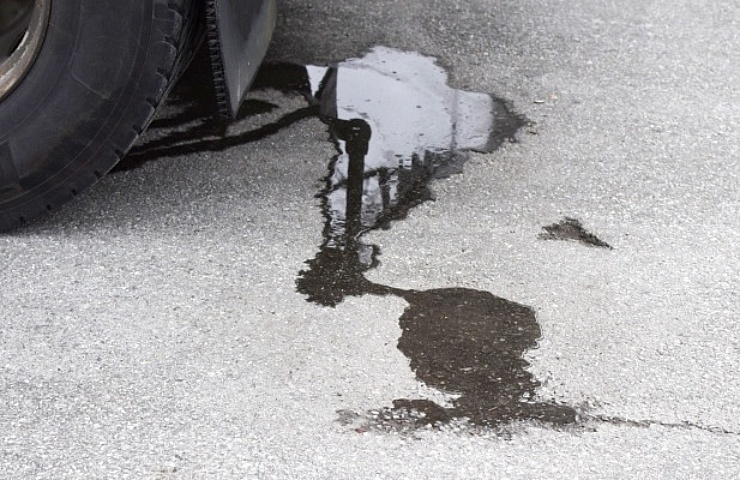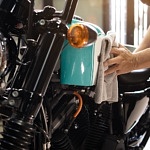Contents
There are two common signs that your engine is leaking:
- Fluid below the vehicle. Depending on where the leak occurs, the fluid can be in the front or rear of the engine.
- Low fluid levels. As the fluid leaks, you will have to top off the system.
When either occurs, it’s essential to troubleshoot so you can resolve the problem quickly before further damage happens.
What is Leaking from Your Engine?
The easiest way to determine what is leaking is to look at the color and consistency of the fluid. If you can’t get a good look at it, put a piece of cardboard under the vehicle to inspect the drops closer.
Here are the characteristics of common engine compartment leaks:
- Brake fluid – Brake fluid is typically transparent yellow, almost completely clear. But it can turn brown if it’s older. With a brake fluid leak, drips likely come from the master cylinder reservoir under the hood near the firewall or from one of the lines running to the brakes.
- Coolant – Coolant is easy to identify because it’s bright. It may be green, pink, or orange, but it looks very different from motor oil. It also has a sweet smell and a water-like consistency. With leaking coolant, you may also notice the engine start to overheat. Coolant typically leaks from loose clamps, a broken water pump, or a defective radiator. It can also come from any of the hoses.
- Engine oil – Leaked oil is light brown when it’s new and black when it’s older. It usually leaks directly below the engine. Engine oil leaks often occur because of bad gaskets or seals.
- Power steering fluid – This leak may appear to come from the engine, but it’s not. If you see a clear or red fluid, you may think it’s transmission fluid. That’s why a deeper inspection is needed to determine the source of the leak. In this case, the liquid comes from either the power steering fluid reservoir or the lines.
- Transmission fluid – Red dye is added to most transmission fluids to help you identify it. However, when it’s older, it may look brown. While this may appear to be an engine leak, it comes from the transmission or lines running to the cooler.
- Water – There’s no reason to worry if you see water dripping under the car. It’s usually normal condensation buildup from the air conditioning system. This drainage is ordinary and necessary for the air conditioning to work correctly.
Techniques to Find an Engine Leak
There are several methods for finding a leak from under the hood. Let’s start by looking at strategies for discovering an oil leak.
Visual Inspection of Engine
- Carefully look around the engine to see where the leak occurs.
- Clean off the engine to remove any oil that may have blown to different areas.
- Take the vehicle for a short drive if possible so the oil leaks again.
- Inspect the engine again to determine if it’s easier to see the leak.
UV Leak Detection
- If you can’t spot the leak, buy a UV dye tracer to pinpoint the cause.
- Follow the directions on the product and dump the appropriate amount into the oil.
- Drive the vehicle for a short time.
- Use the special light detector included with the kit to spot the UV dye and oil coming out of the engine.
Visual Inspection of Cooling System
- Perform a visual inspection, looking for leaking coolant.
- If you don’t see an area of the engine leaking the coolant, check the other components, such as the radiator, hoses, and clamps.
- If no leak is found, use a pressure tester attached to the radiator to pressurize the system, making it easier to find the leak.
Internal vs. External Leaks
If you don’t see a leak but continually fill up the oil or coolant reservoir, you may be dealing with an internal leak. The engine is filled with numerous channels and pathways that could malfunction. If a leak occurs internally, you won’t see fluid coming out of the engine. Instead, the leak is infiltrating areas of the engine where it doesn’t belong.
Whether the coolant is leaking into the oil or vice versa, you may see a cloudy substance when you check the oil or coolant levels. This problem indicates the two fluids are mixing. This problem is often the result of a blown head gasket.
How to Repair a Leak
If you find an oil leak, it’s crucial to repair it immediately before engine damage occurs. The fix depends on what’s causing the leak in the first place. You must replace the offending component, whether a bad seal, a damaged oil filter, or a loose hose.
If you are dealing with a minor leak or seepage through a seal, you may be able to use a stop leak additive. These products work short-term because of the solvents and detergents in the formula. However, the additive may not provide a permanent fix to the problem, leaving you to repair it anyway in the future.
The method to repair a coolant leak is similar to how oil leaks are fixed. You should determine what part is faulty and replace it. You could replace a clamp, hose, or radiator in this case.
Shop now for radiatorsA radiator-stop leak product can provide a cheap and easy solution to minor problems. However, it’s typically messy and never considered a permanent solution. On top of that, it can lead to more damage and expense in the long run.
How Much Does It Cost to Repair a Leak?
The cost of repair depends on what needs to be fixed. Here are a few rough estimates based on you doing the labor yourself. These prices vary based on what type of vehicle you drive.
- Oil filter: $5 to $35
- Oil pan gasket: $75 to $150
- Oil drain plug: $3 to $25
- Valve cover gasket: $5 to $45
- Front crank seal: $50 to $90
- Rear main seal: $20 to $55
- Radiator: $500 to $1,100
- Coolant tube or hose: $15 to $125
- Water pump: $125 to $375
Once the repair is finished, remember to top off the system with the right amount of motor oil or antifreeze.
Shop now for antifreeze







